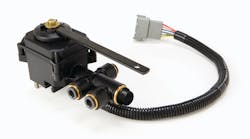Hadley, a supplier of quality components and solutions for the Class 5 to 8 vehicles, has introduced its SmartValve Electronic Height Control System. The announcement was made the recent Technology & Maintenance Council's Annual Meeting held in Nashville, TN, last week.
The SmartValve saves drivers time and effort, helps reduce injuries and landing gear damage and can improve fuel economy.
SmartValve provides fleets with a competitive advantage in recruiting and retaining drivers and improving fuel economy, said Bob Dubsky, president of Hadley. With numerous benefits important to fleets, it pays for itself in six months or less.
New approach to electronic height control
Until now, electronic height control systems have required several separate components: the valve manifold itself, an external sensor and the associated electronics, Dubsky noted. Hadley's SmartValve combines these devices into one simplified and compact solution, fitting within the same envelope as a mechanical height control valve.
"The SmartValve is based on Hadley's proven Smart Air Management System technology used for more than 10 years in rugged specialty vehicle operations," he said. "We are confident that this cost-effective, integrated system will be quickly adopted by the mainstream Class 8 markets, because SmartValve's wide-ranging benefits are tailored specifically to them."
Drop-and-Hook
SmartValve installed on the drive axle suspension saves time and money in a variety of common drop-and-hook situations, getting drivers back on the road quickly.
By conveniently raising the tractor frame over ride height, drivers can reduce the time and effort required in coupling with trailers found at many different ride heights, explained Dubsky. There is no need to crank the landing gear as often or as far, and fewer trips out of the cab are required for adjustment.
Less drop-and-hook time means drivers are able to spend more time with their families, added Bob Zirlin, Hadley's director of marketing. "New Hours-of-Service regulations put a premium on drivers' time. SmartValve makes that time more efficient."
Extensive testing at the Bosch Automotive Proving Grounds validated the time saved by SmartValve in these operations as compared with mechanical height control valves.
In high-frequency drop-and-hook, he said the SmartValve saves each driver a week's worth of time, every year. That equates to increased productivity and annual savings of $1,350 per driver for the fleet.
SmartValve also dramatically reduces the driver effort required in drop-and-hook, added Zirlin. With a mechanical valve, if the trailer is too high when coupling, drivers are forced to adjust the landing gear with the weight of the trailer fully resting on the landing gear and suspension. The result is more strenuous cranking and back strain, more time needed to adjust, and multiple trips out of the cab.
In the same situation, but with a SmartValve, the driver can couple the tractor and trailer by simply raising the tractor frame over ride height, thus lifting the trailer and load. This allows for easy final adjustment of the landing gear.
What if the trailer is too low? With a mechanical valve, the tires of the tractor may hit the trailer while backing up. To raise the trailer by cranking the landing gear, the driver has to struggle against the weight of the trailer, especially if fully loaded.
With SmartValve, the driver simply raises the tractor frame over ride height, thus lifting the trailer and reducing the effort needed to crank the gear, Zirlin said. "This means safer, easier coupling and greater driver satisfaction."
Insurance industry officials say that raising and lowering landing gear is one of the top sources of injuries in trucking, he pointed out. SmartValve eliminates these injuries by reducing the strenuous effort required to crank the landing gear. Fleets will benefit through reduced workers' compensation premiums.
SmartValve's drop-and-hook benefits in saving time and effort result in a much better working environment and greatly improved driver comfort, said Zirlin. "SmartValve can be an important recruiting tool for the many fleets facing driver shortages today."
Improved fuel economy
The SmartValve Electronic Height Control System can also help fleets save fuel. Fuel economy is improved through greater ride height accuracy, resulting in reduced compressor run time and avoidance of unnecessary valve actuations, Dubsky said.
SmartValve provides OEMs with a tool to design more aerodynamic tractors, which automatically lower vehicle ride heights at highway speeds, he noted.
Hadley tested this technology at the Bosch Automotive Proving Grounds with extensive SAE J1321 Type II Fuel Economy Testing. The results show a 0.7 percent improvement on the specific tractor model tested at low ride height.
With new tractor designs, said Dubsky that could mean savings of $700 or more annually for every tractor in the fleet. A 100 tractor fleet would save 17,500 gallons of diesel every year.
The SmartValve Electronic Height Control System is available now as a retrofit kit for specific applications, with additional coverage expanding in the months ahead. SmartValve will be available later this year for OE installation.
To learn more, visit www.hadleyadvantage.com.



